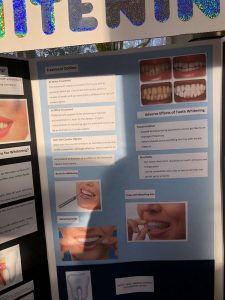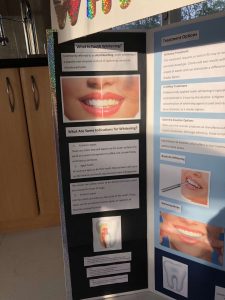Purpose:
- Our presentation is talking about teeth whitening and the different options available to you.
How does Tooth Whitening Work?
- Enamel is porous, which means that overtime staining agent are able to make their way down into the enamel.
- Hydrogen or carbamide peroxide in the whitening solution opens up these microtubules in the enamel. This aids in bleaching agent in getting down into the tooth enamel and setting off a chemical reaction that breaks apart the staining compounds.
- Tooth Whitening only works on a natural tooth structure.
What are Some Indications for Whitening?
- Extrinsic stains are stains that will appear on the outer surface of a tooth as a result of exposure
to staining drinks or foods such as coffee, tea, certain foods, or tobacco products. - Aged teeth are an indication for whitening. As you age so do your teeth. Natural wear will occur
on them enamel which is the outer most layer of your tooth. When this happens your teeth
may become more transparent and reveal the yellowish colour of the next layer of your tooth
called dentin. - Intrinsic stains are stains that are on the inside of the tooth. These stains are caused by trauma,
aging, or ingestions of fluoride which can cause something called fluorosis.
Treatment Options
- The first option is an at home whitening treatment. This treatment requires a custom fit tray as well as peroxide based gels. Clients will see results within a couple of weeks and can see results of up to 6 shades lighter!
- The next option for whitening is in office treatment, this is done with professionally applied in 1 hour by the dentist. A higher concentration of whitening agent is used and results can be as dramatic as 5 shades lighter than previously.
- The last option for whitening is the over the counter option. Most of these products are manufactured by oral health companies like Crest, and although these products can be effective they don’t always produce as dramatic of an effect as the treatment options listed above. Some examples of over the counter options are whitening strips or brush on whitening.
- Although whitening can help you achieve a whiter smile, sometimes whitening can have adverse effects in the mouth. The main adverse effects are tissue irritation and sensitivity. Tissue irritation occurs when tissues are exposed to excess gel due to an improper fitting tray. A client can avoid this from occurring by not overfilling the tray with the peroxide gel. Sensitivity can cause short term reactivity within the tooth from touch, pressure and temperature. The tingling sensations can be immediate or last a day or two at the most and sometimes even persists up to a month. It is important that if you get any sensitivity to contact the dentist and let them know and they can help to try and avoid sensitivity in the future.



http://www.cda-adc.ca/en/oral_health/procedures/teeth_whitening/ Modern Dental Assisting Textbook

